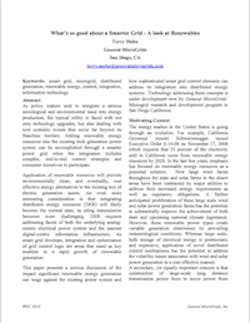As policy makers seek to integrate a serious sociological and environmental issue into renewable energy production, the typical utility is faced with not only technology upgrades, but also dealing with new systemic events that occur far beyond its franchise borders. Adding renewable energy resources into the existing bulk generation power system can be accomplished through a smarter power grid when the integration includes complex, end-to-end control strategies and consumer incentives to participate.
Application of renewable resources will provide environmentally clean, and eventually, cost effective energy alternatives to the existing mix of electric generation assets. An even more interesting consideration is that integrating distributed energy resources (DER) will likely become the normal state, as siting transmission becomes more challenging. DER requires addressing facets of both the underlying analog- centric electrical power system and the nascent digital-centric information infrastructure. As smart grid develops, integration and optimization of grid control logic are areas that stand as key enablers to a rapid growth of renewable generation.
